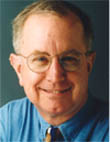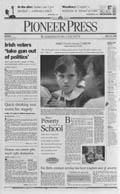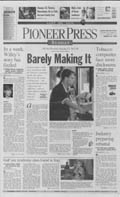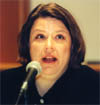The St. Paul Pioneer Press
“Poverty Among Us”
An illuminating look at the underclass that combined detailed reporting with strong storytelling and compelling photography. It provided some wonderful hooks (“Do the Math,” to show what people have to live on, for example). Civic participation moved to a new level with the concepts of a tool kit, discussion guides and a book club, reinforcing the idea that informed citizens are best equipped to deal with pressing public issues.
– The Batten Award Judges
Walker Lundy, Editor:
 “The previous year, one of our best reporters, Lynda McDonnell, had written a lot of stories about welfare reform and how that was changing our community. She and her editor, Kate Parry, came to the conclusion that government was changing the rules and that meant the rules for our community were changing. So the idea was that we could write about the issue of poverty in ways that would let our readers see there were things that they, personally, could do to make things better.
“The previous year, one of our best reporters, Lynda McDonnell, had written a lot of stories about welfare reform and how that was changing our community. She and her editor, Kate Parry, came to the conclusion that government was changing the rules and that meant the rules for our community were changing. So the idea was that we could write about the issue of poverty in ways that would let our readers see there were things that they, personally, could do to make things better.
 “I think we began by just pulling a bunch of people into the room and brainstorming ideas and they hit upon the idea of one Sunday a month for seven months, that way you didn’t inundate the reader, overwhelm the reader right away with all of this stuff.
“I think we began by just pulling a bunch of people into the room and brainstorming ideas and they hit upon the idea of one Sunday a month for seven months, that way you didn’t inundate the reader, overwhelm the reader right away with all of this stuff.
“Glenda Holste from the editorial page began working with book clubs, which was a new idea for us this year. We didn’t know whether people would respond to it or not and, of course, people went nuts with the idea.
“Well, we took a different subject every month that tied in with the issue of poverty and wrote about the people who were involved. One of the best things we did … each month we would look at the particular issue – whether it was housing, whether it was education, whether it was health – from a child’s point of view and the reporter would talk to a child or some children and try to get their viewpoint of what the issue looked like through their eyes.
 “The book club idea was an easy, constructive way that people could interact with this project and I think we had something like 2,500 people by the time it was all over, reading books, getting together discussing the topics. Again, the whole thrust was towards: What can I, as an individual, do to deal with the issue of poverty in my community?
“The book club idea was an easy, constructive way that people could interact with this project and I think we had something like 2,500 people by the time it was all over, reading books, getting together discussing the topics. Again, the whole thrust was towards: What can I, as an individual, do to deal with the issue of poverty in my community?
 “Well, they responded in a lot of ways I think we’ll never know about … but we heard from lots of people who said, ‘I like the series, I was motivated. My church group did this or my civic group did this or the neighborhood’s going to do this.’ But I believe, based on what we got, that there were lots of people in the Twin Cities who said, ‘There’s something that I can personally do to attack the issue of poverty and I’m going to do it.’ And I think they did it as the result of our series.”
“Well, they responded in a lot of ways I think we’ll never know about … but we heard from lots of people who said, ‘I like the series, I was motivated. My church group did this or my civic group did this or the neighborhood’s going to do this.’ But I believe, based on what we got, that there were lots of people in the Twin Cities who said, ‘There’s something that I can personally do to attack the issue of poverty and I’m going to do it.’ And I think they did it as the result of our series.”
“Public journalism is nothing more than very good journalism done in ways that draw readers into the story and give them something to do as a result of what they read.
“And, I mean, it does sound corny, but there is a reason why we’re mentioned in the First Amendment. And it’s not because we run the TV listings and it’s not because we have the sports scores, although we should have those and it’s very important.
“The reason we’re written into the First Amendment is because we’re crucial to democracy and nothing demonstrates that better in my mind than great public journalism.”
Kate Parry, Senior Editor:
 “We talked early in the poverty project about how we would measure success, how we would determine whether we had achieved our goal of causing our community to hold a large public conversation. We decided fairly quickly that the best measure we would have would be numbers. We would count how many people got involved. It was a crude measure. We know that 2,500 people showed up at formal discussions or book clubs, about evenly split between the two. We felt that was quite successful.
“We talked early in the poverty project about how we would measure success, how we would determine whether we had achieved our goal of causing our community to hold a large public conversation. We decided fairly quickly that the best measure we would have would be numbers. We would count how many people got involved. It was a crude measure. We know that 2,500 people showed up at formal discussions or book clubs, about evenly split between the two. We felt that was quite successful.
 “It was interesting to me then, about six months later, when the project’s lead reporter, Lynda McDonnell, moved to a new job as the politics team leader. She was planning election coverage and one of the first things she did was look across the desk at me and said, ‘How are we going to measure success on elections? What will we have to do for citizens between now and election day in order to say we covered this election well?’
“It was interesting to me then, about six months later, when the project’s lead reporter, Lynda McDonnell, moved to a new job as the politics team leader. She was planning election coverage and one of the first things she did was look across the desk at me and said, ‘How are we going to measure success on elections? What will we have to do for citizens between now and election day in order to say we covered this election well?’
“So the idea of thinking further down the road than we’re used to doing in newspapers and figuring out how we will measure success in a citizen-based way has come right out of the [civic journalism] projects and into our daily coverage of politics and government. That’s a very nice way to mainstream some of the things we’ve come to assume are just part of the fabric of civic or public journalism in these big projects.
“It would be a good way for any beat reporter to think about their work. It’s so easy to get caught up in the hubbub of covering the daily news and not really be thinking down the line, ‘What’s my responsibility in the end?'”
